Growing up in a post-war cookie-cutter housing development so typical of 1970’s suburban New Jersey, I would often “garbage-pick” old bicycles, or parts thereof, and construct functioning machines that while not quite as aesthetic as my friends’ new Schwinn Stingrays or Orange Krates, nonetheless afforded me my single most important means of independence. My teenage friends and I would pedal our bikes to the extremes of our neighborhood, continuously expanding those limits with each passing summer until finally earning our drivers licenses on our seventeenth birthdays. For many years, North Wood Avenue, a heavily trafficked street just four-blocks west of my house, served as one of our unofficial boundaries, as that avenue formed the border between my hometown of Linden and the neighboring Borough of Roselle. Since crossing the traffic on a bicycle could be dangerous, and since the other side was a different town populated by different kids who went to different schools, we viewed that opposite side as foreign territory, venturing into Roselle on only limited occasions.
Not that the other side didn’t hold any allure, rather just the opposite. Just two blocks into Roselle was one corner of the Roselle Golf Course. On the far side of that golf course across Raritan Road, lay Smith’s Woods, a good-sized parcel of wooded property that concealed a somewhat dilapidated, but no doubt once ornate mansion homestead that we considered the most haunted house in New Jersey. Heading back on Raritan Road, we would never miss the opportunity to stop and rest at the Abraham Clark “Rock,” a landmark frozen in place for nearly the last two hundred and fifty years. Recently I took the opportunity to retrace some of these explorations of youth and traversed those same grounds, now almost forty-years removed.
Our first stop would always be the golf course and it didn’t take long before we knew every hole in the fence that allowed us access onto the beautifully landscaped grounds. Our visits never lasted long, our brief incursions usually ending with foot chases and threats of police being called, as we would sprint to the sanctuary of our bicycles waiting at the hole in the fence. After one such incursion, I asked my dad to take me golfing at the course one day, at which point he took the opportunity to impart an early life lesson. At first I didn’t understand the concept when he said that we would not be allowed to play at the golf course, explaining that it was a private country club that required membership that was limited to more wealthy folk than we. He then continued by saying that we would only be allowed to golf at public courses that were opened to anyone. As I slowly began to comprehend the idea of private property and membership, it began to make sense to me, but I nonetheless lamented that such a neat place existed so close to my own house, yet somehow it remained beyond any experience other than our brief trespassing episodes. To our youthful imaginations, the beautiful open grounds of the golf course afforded the feel of a war-time no-man’s-land, a restricted off-limits zone that teased us with the close proximity to home.

Sneaking onto the verdant grounds never failed to make us feel far, far away from home, certainly not a mere six blocks. One reason was certainly the openness of the land, and while Roselle Golf Club’s 60-acres were considered small by golf course standards, it seemed an endless expanse to a youth growing up in a crowded corner of Union County. Another alluring feature of the golf course was the creek that ran through the property and the numerous footbridges that crossed over the stream, which would allow us the overhead perspective to observe the plentiful darting minnows in the slow trickling current. But the biggest reason I was so drawn to the golf course was the trees; they all seemed so different from the run-of-the-mill Pin Oaks and forever-peeling Sycamores that lined our nearby neighborhood streets. The trees on the golf course seemed so much more majestic, so much bigger, so much older; simply more exotic. I would stare at the different species of majestic towering pines and the gnarly twisted hardwoods that shed unfamiliar leaves, and silently wish that such stately behemoths graced my backyard.


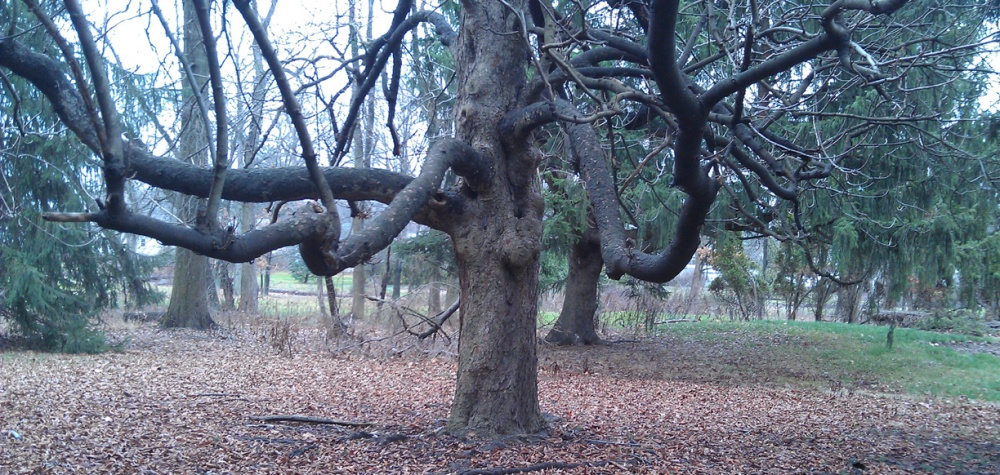
Once, when I was in my twenties and had graduated college, I was ecstatic to receive my first invitation to actually play golf at the course. Unbeknownst to me, my uncle had taken a recent affinity to the sport and had decided to become a member. I didn’t hesitate and pounced on the opportunity when he asked me to join him and his friends for a round of golf at the course. I went on to play a few more times with him and my appreciation of the course was renewed, this time because I was a guest, perhaps even a potential member, but certainly no longer a shunned trespasser.
Eager to learn more about the history of the course, my research revealed that that the club had come into existence back in 1917, founded by a group of local men who owned the Roselle Casino in town. (Casinos were common places of social gathering in numerous New Jersey municipalities before the turn of the century.) When Roselle’s casino burned down in 1916, this group of men decided that rather than rebuild their casino, they would purchase the nearby Chilvers family farm and build a golf course on the land, as the sport was rapidly growing in popularity in those early years. They went on to hire one of the country’s leading golf course architects to design and build their course.
Seth Reynor was a highly sought-after golf course designer, and while he himself was oddly never an avid golfer, he was the protégé of Charles Blair Macdonald, the foremost figure in early American golf. Macdonald built the first 18-hole course in the United States, won the first amateur championship played in 1895, and had been a driving force in the founding of the United States Golf Association. After later building some of the most influential golf courses in the United States, Macdonald became known as the father of American golf course architecture. Since he never worked for payment, yet was under considerable demand for his services, he began collaborating with the young Seth Raynor, who then went on to become a prolific designer in his own right. Mr. Raynor designed more than one hundred golf courses up and down the East Coast with others ranging as far west as Hawaii before his unexpected and untimely passing in 1926 at the age of 51 years old. It was his imaginative eyes that were responsible for the design layout of the 60-acre former farm, including the contouring of the land, the placement of the sand traps and bunkers, and the planting and placement of the varied species of trees.
Revisiting the golf course more than forty-years since I first appreciated his inspired landscape, and as we currently approach what would have been the one hundredth anniversary of its founding, I am sad to report that that the Roselle Golf Course is no more. Waning membership and growing expenses led to the demise of the club and like so many valuable parcels of land in New Jersey, it soon became the target of an eager developer; immediately a 1,600 unit apartment complex on the spacious tract of land was proposed. Since so many cash-strapped New Jersey municipalities salivate at the prospect of a new tax-generating rate-able, plans and drawings were soon feverishly being worked on. Some local residents soon voiced concern about the scale of such a project and the loss of the 60-acre suburban rarity. After a few years of tumultuous debate, the project was scaled back to fewer than 1,000 units, with the added concession that the 20-acres containing the oldest and most stately of the trees would be preserved as a park for all to enjoy.

It was this project’s recent groundbreaking that prompted my step-retracing, as I once more became a Sunday afternoon trespasser, sneaking in through the very same hole in the fence that I recalled from my youth. The changes I would be about to witness made me feel quite sad. I was greeted by the sight of a three-story high pile of tree “parts” that was stacked adjacent to a frighteningly massive chipping-machine sitting idle nearby. The machine could not have been idle for too long, for it was surrounded by mounds of wood chips that were no doubt the sad fate of many of the majestic 100-year old behemoths that I once found so dear. Wooden stakes with plastic sheathing and endless yards of yellow caution tape cut mazes into the vast former fairways, precisely marking the panned upheaval of the very earth that Mr. Raynor so affectionately contoured a century earlier. (I can update that this work is well underway, as acres of fairway grass have now been uprooted and transformed into vast fields of mud and melting snow when I last drove by.)
Wandering around the old course, I noted how odd it looked with all of the greens and sand traps already removed, simply scraped out of the earth. I crossed the old footbridges, weathered but sound, glimpsing the familiar minnows darting about, this time avoiding garbage which has accumulated in the creek and evidently is no longer regularly removed. As I wandered the perimeter of the property, I made sure to avoid a line of sight with the police cars parked in the distance, one positioned in the country club’s former main parking lot and another across the street in the parking lot of Roselle Catholic High School, knowing that these officers were posted to observe and prevent intruders such as myself. I admired the 100-year old trees that were still standing, some appearing to me as if they greatly predated 1917, and I wondered which ones were yet fated to end up as mulch. Countless squirrels still raced up the trees, oblivious to the impending changes they will soon be encountering as well.

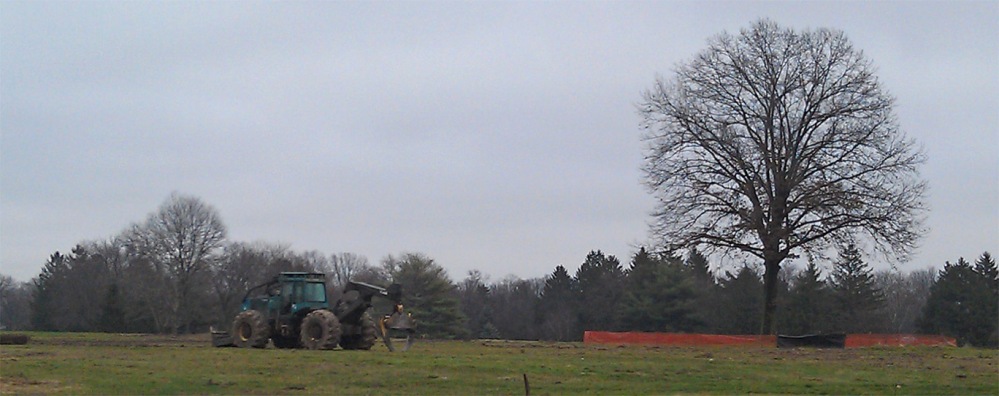


Since this beautiful property was never available for the enjoyment of the entire community, and while I disdain the additional crowding of more people and buildings, I tried to see the silver lining in the fact that at least a portion of this beautiful parcel will be preserved as a park that will be open for all to share. It’s usually much easier to blame it on greed and curse those in authority who make the decisions that allow for the loss of hard-to-find open space in New Jersey, but this dilemma will continue to be a source of personal pondering for me for some time, as my opinion teeters on both the pro’s and con’s of this entire development project
Upon crossing old Raritan Road, I was now facing the property known as Smith’s Woods, an area that truly frightened me and my friends when we were young. Forty-years ago, the property was a heavy thicket of woods, bounded on one side by a sizable field of knee-high grass that always turned a golden shade of blond in late summer. This field was no doubt once farmland, but for us it took on a whole new scary vibe the day we discovered three small tombstones set flush to the ground just past the edge of the woods. To our surprise, the three neatly engraved barely-weathered stones marked the graves of a family’s pets; if my memory serves correctly, one was for a Great Dane, another a horse and the final a pig. They all dated to the second decade of the 1900’s or so and each included a short phrase describing the loving loyalty or fond faithfulness of the pet interred. This discovery of a pet cemetery, long before Steven King’s movie of a similar theme, seemed to us the epitome of creepiness.
The story we had ascertained was that the mansion had been built around 1912 by a wealthy business man, Henry Smith. One of his sons was a mad-scientist-type inventor named Henry Such Smith, whose claim to fame was supposedly designing the Jersey Barrier, the geometrically-shaped concrete traffic dividers that today line countless miles of highway throughout the nation. The mansion has evidently remained in the family, last being the residence of the Smith widow.
As teenage trespassers, stepping into those woods seemed like a quantum leap in danger. The canopy was so thick that the penetrating sunlight seemed to drop off a few orders of magnitude in just a few steps. Scattered seemingly randomly about the wooded property, were large white statues, most standing taller than we did. Some resembled oversized birdbaths or perhaps fountains, but with designs most sinister; one sported a large set of ram’s horns that we immediately associated as a demonic symbol of sorts. There was an outer building that seemed to serve as a garage, and once upon venturing close enough to peer in a cracked window, I swear I saw a human skull perched on a ledge inside.
The dense woods extended directly adjacent to the old mansion, which even then seemed dilapidated as we tried to focus on it from a distance through the trees, but rarely did we ever venture very close, as no matter how stealthily we encroached, someone always seemed to be aware of our presence and inevitably a terrifying chase would ensue. A heart-pounding all-out dash to our waiting bicycles at the fringe of the woods would be the end result; no one ever dared turn around while pedaling away.
Smith’s Woods saw its demise not long after our explorations. I may have started high school when the rumble of chainsaws obliterated most of the forest and within a summer or two, rows of townhouses sprouted across the property. Soon a sign introducing the new development, Westbrook Woods, graced both ends of the property. While no longer immediately bounded by the heavy thicket, an asphalt parking lot adjacent to one of the condominium units literally extended to nearly the front door of the frightful mansion. Since the old mansion was not razed, I presumed that someone had intentions to make the effort to restore it to its former grandeur, as it must have been a most impressive residence when built.


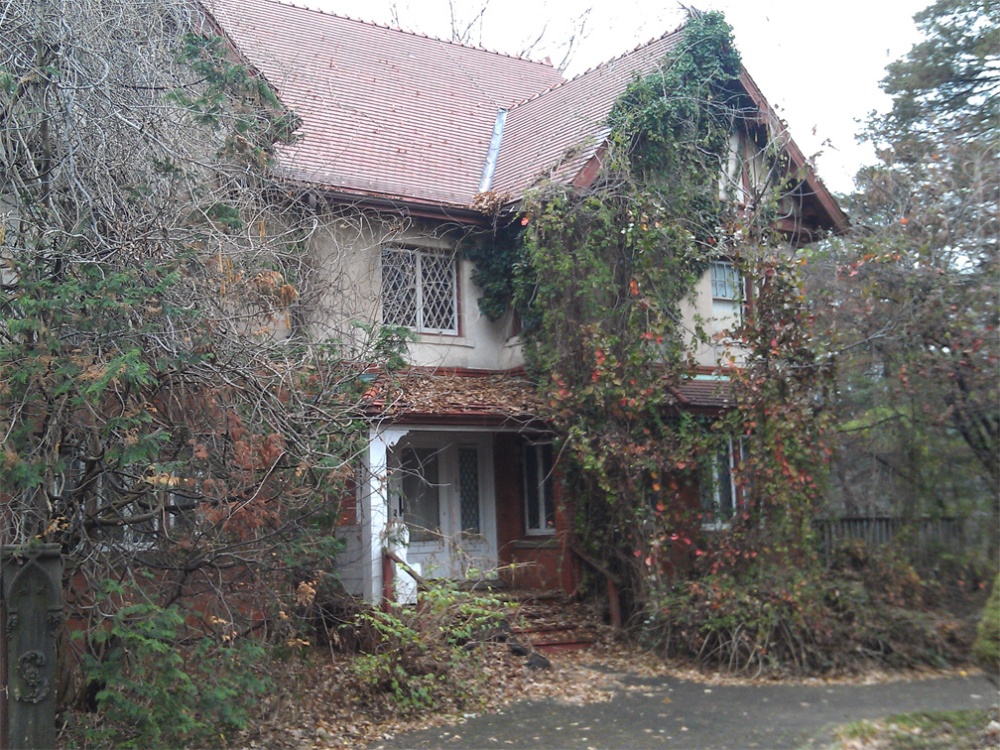
On my current visit, I walked through the adjacent parking lot and completely around the perimeter of the old haunted building, observing that it was now in a far more advanced stage of decline. Ornate concrete gate pillars bearing an embossed floral capital letter “S,” the final testament to Mr. Smith, adorn the front and rear of the building, the shadier of the two stained green with moss and algae. Dense ivy now climbs up the exterior walls to the roof, pulling down terracotta gutters and obscuring windows already sporting cracks. Vines once draped in spider-web fashion have intertwined around each other, creating a near perfect spiral of what appears to be braided rope. Made of one-inch thick wood, it is the end result of years of Nature’s incessant growth.
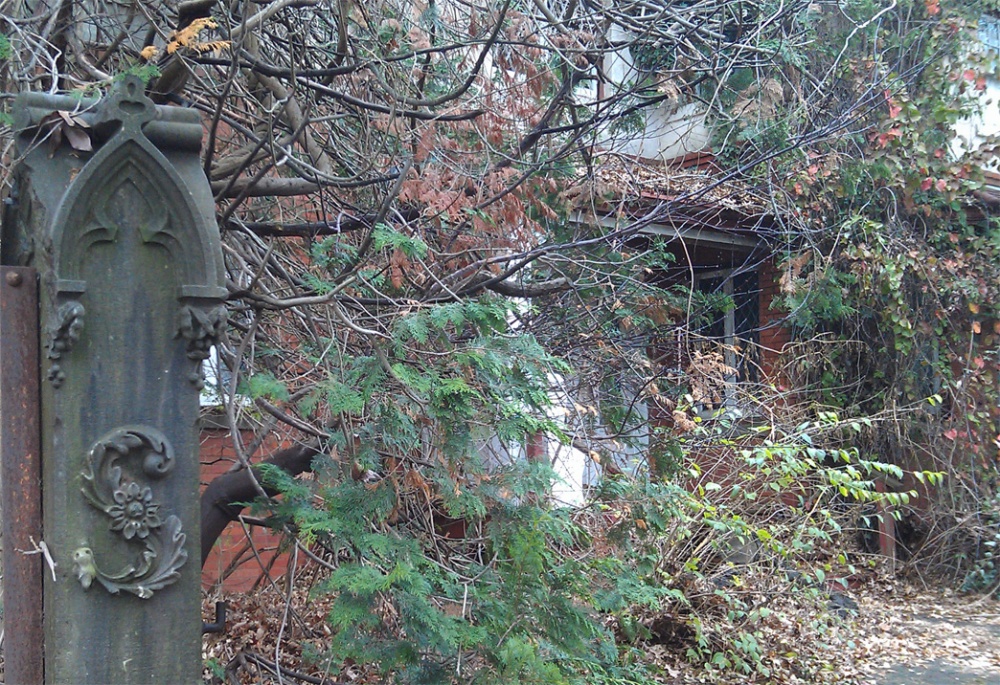



My assumption of a planned restoration was confirmed upon seeing the odd juxtaposition of a completely collapsed roof over the back entrance, allowing the elements in, yet at the same time adhered to the inner surface of the glass sliding door beneath it was a sun-faded Anderson Windows sticker. Closer examination of all of the windows suggested other hi-end replacements as well; someone had started the restoration project, yet for reasons unknown, it ceased some time ago. Wile no longer shrouded by forest, the still seemingly haunted house, coupled with my memories from forty-years ago, combined to keep me on the edge of my toes, as if an all-out sprint could be required at a moment’s notice should someone, or something, emerge from the decrepit structure.

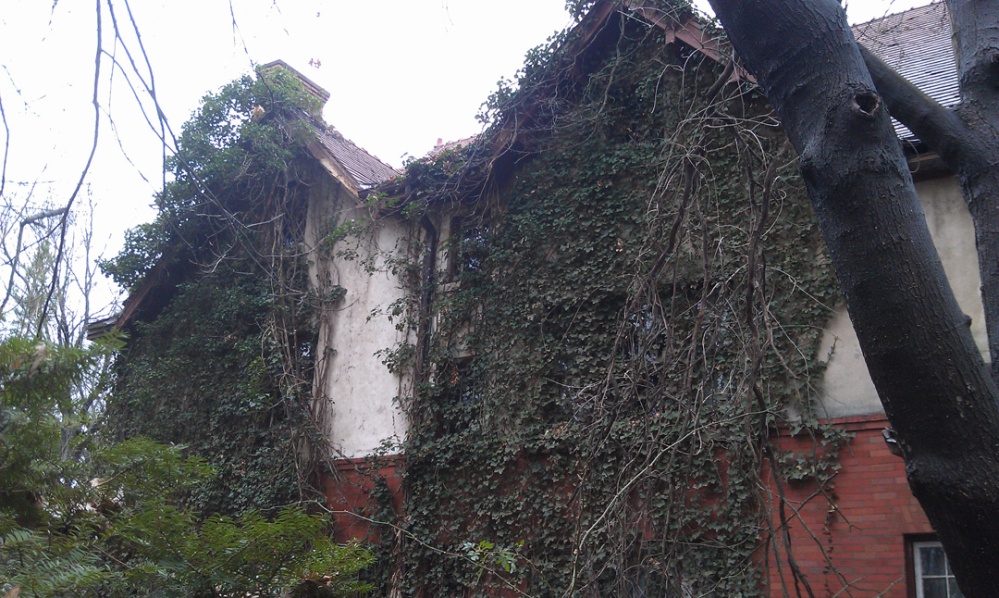

Happy to leave the creepy abode that still managed to lift the hairs on the back of my neck, I continued my trek and headed back towards Linden. My final destination lay ahead on Raritan Road, the aforementioned Abraham Clark Rock, located behind a shuttered supermarket parking lot in the now-dated Roselle Shopping Center. It is a sizable sandstone boulder, reddish-brown in color, so typical of many of the old colonial tombstones or old churches that used to be constructed with the native New Jersey rock. The boulder has a natural point to its shape, perfectly intended for its intended task as a boundary marker, for on one face is carved the initials AC, while the other side bears both RC and the still neatly chiseled date of 1737 positioned just below. While many a colonial tombstone has lost much of its detail to the harsh erosion of two centuries exposure to the elements, this incised date remains almost pristine.
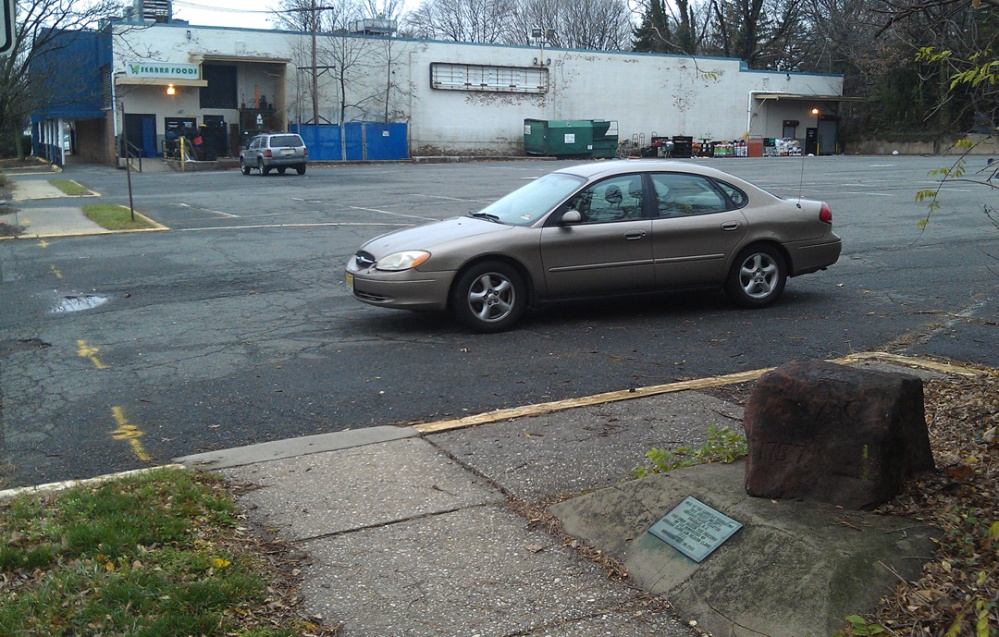


This distinct boulder was used as a boundary marker separating the properties owned by relatives Abraham and Richard Clark, but while our history classes taught us that Abraham Clark was one of the five signers of the Declaration of Independence from New Jersey, these initials corresponded to a pair of his family’s earlier ancestors two generations prior. We often parked our bicycles and sat on the rock, pondering the fact that it had been there for almost forty years even prior to the Declaration of Independence’s announcement of the birth of our new nation. Sadly, I’d be willing to wager that most people who live in the Linden/Roselle area are completely unaware of its existence, despite the fact that it has now stood sentinel in place for a remarkable 289 years, its obscure location probably contributing to its continued existence.
The inspired circular-shaped strip mall design was uniquely ahead of its time when constructed in 1951, leaving the historic rock hidden in plain sight on a small plot of ground on the furthest edge of the mall property. In fact, the rock sits on a 10’ by 10’ plot of ground owned not by the shopping center, but rather owned by the Borough of Roselle. After the Roselle Shopping Center was built, the Sons of the American Revolution had the foresight to rededicate the boundary rock in 1952, sitting it in a secure cement base and emblazoning it with a bronze plaque explaining its significance. There it has resided ever since, and hopefully forever henceforth, in the forgotten back parking lot of a shuttered supermarket.

A few more yards down Raritan Road and I was in the middle of the shopping center, passing the crowded Dunkin Donuts and then again crossing Wood Avenue back to my home turf of Linden. I had stirred a lot of memories, seen a lot of changes, and seen many things the way I remember them. Thus has been the story of New Jersey throughout time, my own personal experience now allowing for the perspective of four decades. I look forward to making the trek once more when the new park is officially established. Who knows what changes will await me then?
Always a pleasure to read your blogs.Nice work!!!
LikeLike
Thanks for the wonderful and sad story Fred. I’m always saddened to see beautiful homes lost to neglect.
LikeLike
Great piece. Very well written. Thanks for the remembrance as I had many of the same experiences, especially relating to Smith’s Woods. The darkness and spookiness, the outright fright, and being chased I experienced as well. I laughed so hard reading this piece I cried. I went to school with the 2 sons, Eric and Kent. I remember their father drove an old VW bug from the ’50’s. I knew Eric a little. Wasn’t a bad guy but was a little eccentric as I remember him. I currently live literally a football field away from the woods, and can see the former golf course from my front window. Many new buildings are now being erected, much of the framing is done, and windows are going in. I was a caddy there as a youth, rode my toboggan there in the winter. So sad what has happened. Eric Smith still owns the house and some property. He recently contacted me to appraise it. Really hope they leave alone the section designated to be a park. I don’t trust them. Thanks for the article.
LikeLike
I grew up in Roselle along with my brother and sister, we lived on Independence Drive. Just down the block was the entrance to the girl scout property which bordered the Smith property. Those woods provided infinite hours of tree climbing, fort building, digging clay out of the creek, catching box turtles, plastering their shells with decals and then setting them free and hopping freight trains that passed through. Here is an interesting tidbit of information that few remember. When I was in second or third grade which would have been around 1957 or 58, Queen Elizabeth passed through on a train though Roselle. The line was a freight line, she and her entourage were in a passenger car at the end of a freight train. I was in Washington School at the time. All the classes were let out and we watched the train go by, the rails bordered the athletic field behind the school.
LikeLike
I grew up in Roselle, too. I attended Washington School and went to the Girl Scout camp in the late ’50’s, as it was a day camp. I enjoyed this blog post because it reminded me of so many things about my home town that I hadn’t thought about for years, especially the Abraham Clark boundary marker and the spooky Smith woods. I often walked home from Abraham H.S., passing by the woods. Since I never ventured into the golf course grounds, I have no memory of anything other than what you could see through the fence along Raritan Road, but I hope there will be a park there. Maybe I can visit it someday when I visit my aunt, who still lives in Roselle. Thanks so much for posting this!
LikeLike
Graduated from ACHS ’64. Lived at the Woods End apartments on Wood Ave. Almost every school day, I would walk past the AC/RC 1737 stone boundary marker, the golf course and the Smith’s Woods. Found memories. Great article and well written. Thank you.
LikeLike
Wonderful article. I lived on Washington Ave and passed all of the things that you’ve mentioned daily. Thank you for the reminder.
LikeLike